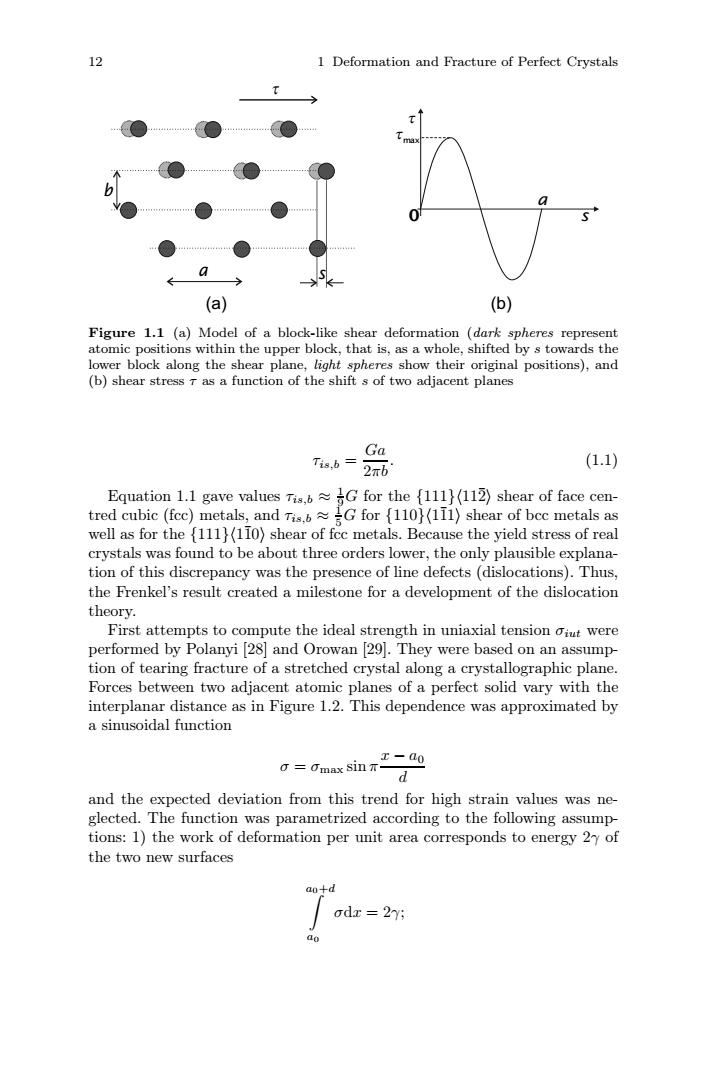正在加载图片...

12 1 Deformation and Fracture of Perfect Crystals (a) (b) Figure 1.1 (a)Model of a block-like shear deformation (dark spheres represent atomic positions within the upper block,that is,as a whole,shifted by s towards the lower block along the shear plane,light spheres show their original positions),and (b)shear stress T as a function of the shift s of two adjacent planes Ga Tis,b= 2xb (1.1) Equation 1.1 gave valuesis,G for the {111)(112)shear of face cen- tred cubic (fcc)metals,and Tis,G for {110)(111)shear of bcc metals as well as for the {111(110)shear of fcc metals.Because the yield stress of real crystals was found to be about three orders lower,the only plausible explana- tion of this discrepancy was the presence of line defects (dislocations).Thus, the Frenkel's result created a milestone for a development of the dislocation theory. First attempts to compute the ideal strength in uniaxial tension oiut were performed by Polanyi [28 and Orowan 29.They were based on an assump- tion of tearing fracture of a stretched crystal along a crystallographic plane. Forces between two adjacent atomic planes of a perfect solid vary with the interplanar distance as in Figure 1.2.This dependence was approximated by a sinusoidal function =dmax sinnto d and the expected deviation from this trend for high strain values was ne- glected.The function was parametrized according to the following assump- tions:1)the work of deformation per unit area corresponds to energy 2y of the two new surfaces ao+d odx 2y; ao12 1 Deformation and Fracture of Perfect Crystals a s b a s 0 max (a) (b) Figure 1.1 (a) Model of a block-like shear deformation (dark spheres represent atomic positions within the upper block, that is, as a whole, shifted by s towards the lower block along the shear plane, light spheres show their original positions), and (b) shear stress τ as a function of the shift s of two adjacent planes τis,b = Ga 2πb . (1.1) Equation 1.1 gave values τis,b ≈ 1 9G for the {111}11¯2 shear of face centred cubic (fcc) metals, and τis,b ≈ 1 5G for {110}1¯11 shear of bcc metals as well as for the {111}1¯10 shear of fcc metals. Because the yield stress of real crystals was found to be about three orders lower, the only plausible explanation of this discrepancy was the presence of line defects (dislocations). Thus, the Frenkel’s result created a milestone for a development of the dislocation theory. First attempts to compute the ideal strength in uniaxial tension σiut were performed by Polanyi [28] and Orowan [29]. They were based on an assumption of tearing fracture of a stretched crystal along a crystallographic plane. Forces between two adjacent atomic planes of a perfect solid vary with the interplanar distance as in Figure 1.2. This dependence was approximated by a sinusoidal function σ = σmax sin π x − a0 d and the expected deviation from this trend for high strain values was neglected. The function was parametrized according to the following assumptions: 1) the work of deformation per unit area corresponds to energy 2γ of the two new surfaces a0+d a0 σdx = 2γ;����